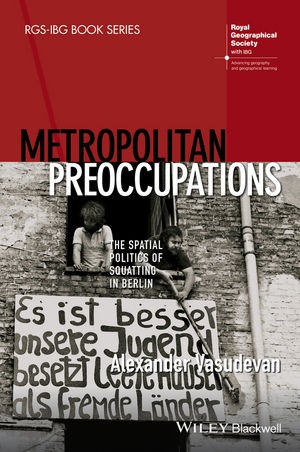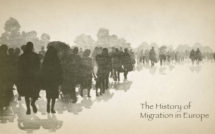
 At times Berlin feels overburdened with history. Every stone in the city has a story to tell, and often these stories are grim. The infamously riotous nightlife of the city might well originate in desperate attempts at escape, not simply from the burden of history, but from the bricks and mortar in which history is materialized. Similar escapism takes Berliners to their Kleingärten, the local type of allotments that characteristically include a hut or even a small house. Often makeshift, the small houses are large enough to allow escape from the city center for a few days or, if needed, longer.
At times Berlin feels overburdened with history. Every stone in the city has a story to tell, and often these stories are grim. The infamously riotous nightlife of the city might well originate in desperate attempts at escape, not simply from the burden of history, but from the bricks and mortar in which history is materialized. Similar escapism takes Berliners to their Kleingärten, the local type of allotments that characteristically include a hut or even a small house. Often makeshift, the small houses are large enough to allow escape from the city center for a few days or, if needed, longer.
One of those Kleingärten settlements is called Kuhle Wampe, located in the eastern outskirts of the city. Today’s Kuhle Wampe derives its name from a previous tent and hut settlement at another location. Socialist workers squatted here to escape overcrowded and overpriced housing in Berlin’s tenement blocks in the first decades of the twentieth century. The Nazis evicted and closed down the settlement in 1934. The original Kuhle Wampe also inspired a movie about working class life in the 1930s of which Berthold Brecht wrote the script. The subtitle of the movie: “Who owns the world?” can be easily answered. Tenants and workers find themselves exposed to what Engels first described as “the housing question,” subject to a domain of capital accumulation and exploitation beyond the factory floor, manifested in the build environment of the city.
Berliners have tried to escape the city ever since it first developed. But far from being merely passive, or reactive, escapes have positively formed the city and its imaginaries. The way the city looks, what it represents, and how it ticks today is to a large extent the stuff of lines of flight.
Alexander Vasudevan’s book Metropolitan Preoccupations explores some of those lines of fight that made the city. He narrates a long history of housing struggles, rent strikes, and squatting that is more than resistance to the impositions of urban capital. Instead, “political activity and the various actions of squatters [are treated] as spatially generative” (11). This productivity of escape becomes very manifest in what is the main empirical focus of Vasudevan’s book: two waves of squatting that have occurred in Berlin in the early 1980s and the early 1990s.
The first wave concentrated in the West Berlin’s most alternative and isolated districts, namely Kreuzberg, and to a lesser extent, Schöneberg. Between 1979 and 1984, 265 apartments and houses were occupied by a scene of squatters that Vasudevan puts at involving up to 2,000 activists. A second wave of squatting unfolded just after the fall of the Wall, and focused on East Berlin districts such as Prenzlauer Berg, Mitte, Friedrichshain, and Lichtenberg, with 183 squats formed.
The second wave is known in Berlin as the long summer of anarchy. It is worth recalling that much more was at stake here than housing. The crumbling authority of the East German state in the months leading up to reunification in October 1990 left a power vacuum in which alternative urbanism flourished. The revolutionary genie was out of the bottle. A few weeks after reunification, with West Berlin authorities now responsible for the whole city, the city mayor ordered a massive police operation against Mainzer Strasse, a street with several squatted houses in Friedrichshain district of Ost-Berlin. The raid involved hundreds of officers from the West Berlin and other West German cities, and lasted for three days, leaving dozens of Squatters injured and arrested. Some police officers were filmed looting the squatters’ apartments. The sheer brutality of the eviction of Mainzer Strasse pushed other squats into hasty negotiations towards legal statuses. More broadly however the raid aimed at chocking the spirit of democratic experimentation that had followed the peaceful revolution in the East.
As Vasudevan makes clear, the practices of squatters in Berlin’s East in the summer of anarchy of 1990 took inspiration from the squatting that had occurred ten years earlier in the West. Both also built on a history of squatting that runs back to the beginning of the city. At the same time, both waves also need to be viewed as unique, and essential idiosyncratic moments of escape, resistance and world-building on their own right. In uncovering these unique moments, the book develops its substantial strength.
At the beginning of the third chapter, Vasudevan nods to Felix Guattari and his call for a micropolitics that builds “new spaces of liberty” or “existential territories” forming an “alternative infrastructure to support and sustain practices of reciprocity, sociablity and worldbuilding” (88).
This could be taken as a wide-ranging theoretical frame, however Vasudevan makes Guattari enter the book not as philosopher, but as an activist involved and invited to speak at the 1978 Tunix conference in West-Berlin. The 1978 Tunix conference brought together an emergent un-dogmatic left keen to escape the stifling antagonism of the confrontation of the state and the Red Army Faction. Tunix marks a shift to a new radical urban politics. It is widely established that Tunix also played an important role in the squatting wave of the early 1980s, as discussed for example by Armin Kuhn’s (2014) study of urban squatting in Berlin and in the broader study of alternative milieus in West Germany by Reichardt (2014).
In Vasudevan’s book we learn how and why attendees of the Tunix conference will have understood Guattari’s call. At some point in the late 1960s, some Berlin activists began to believe that part of the answer to political problems of the day would be to share houses. The formation of communes and shared housing was a remarkable social innovation. Arguably Robert Owen’s ideas of revolutionary conviviality and communality in the early nineteenth century had been broadly forgotten. Since the formation of formal working class organizations and parties in the late nineteenth century, much of the private life of the working classes, their households and family structures, remained essentially untouched by the political quest for emancipation.
Vasudevan narrates how shared living returned as a political practice. Initially, the forming of housing communes was unconnected to questions of real estate regimes. Houses and flats for the new communes were officially rented or even bought. But the communes were formed to make shared social space in which the private was to become political. For feminist politics, this orientation brought an opening as well as a challenge, as communes ended up reproducing patriarchal patterns. However, now out in the open, patriarchal structures in the left could be challenged.
By the time Guattari spoke to Tunix activists in Berlin, most in his audience had made experiences of living with comrades, of sharing social worlds ranging from work to child-care, from joint holidays to commonly organized festivals and gigs. Guattari “existential territories” was not just a concept.
In the unfolding housing crisis of West-Berlin at the end of the 1970s, the political and social infrastructures of communes became tools that made large scale squatting possible. It was political powerful not just in urban occupations descried in Vasudevan’s book. It also expressed itself in large-scale protest camps such as the 1976 Whyl occupation that prevented the building of a nuclear power plant. In the UK similar experiences enabled epochal political acts as the Greenham Common protest camp.
A core strength of the book lies, thus, in telling a history based on materials and practices. In presenting Guattari as an activist rather than a theorist, Vasudevan makes him part of a lively activist history, told for itself and by itself, of urban struggles and their geographies, a theory that operates as practice.
This is equally true with regards to the East-Berlin wave of squatting in the beginning of the 1990s. A history of “Schwarzwohnen” preceded the squatting experience. In the highly regulated housing of East Germany, the state distributed flats to tenants. But since the early 1980s increasing number of East Berlins occupied empty flats without permission from the state. This practice was quietly tolerated by a state that struggled to find resources to maintain a sufficient housing stock. “Schwarzwohnen” often meant putting in necessary repair works and renovations. The DIY urbanism of such practices formed skills and networks of voluntary collaboration, which proved essential in later squatting practices.
Another key strength of Vasudevan’s book is the rich data on which it is based. Extensive fieldwork in Berlin, including interviews and ethnography is coupled with archival research in a comprehensive and rare combination that speaks to both historical and socio-cultural geography. And while the book is explicitly empirical, the conceptual undertones and foundations echo Vasudevan’s larger project of makeshift and autonomous urbanity.
In historical and contemporary perspective, the book could have been easily expanded. Berliners were and continue to be spatially generative. A whole additional chapter could be written about the process in which Berlin’s version of New Age Travellers have squatted, defended and formalised caravan sites in the city since the mid-1990s. And as refugees and recent migrants yet again face the insufficiency of market and state approaches to housing in the city, new spaces are being occupied in the city today, often in conditions of fierce precarity.
Vasudevan provides essential tools to address these emergent metropolitan preoccupations that are by no means limited to Berlin. The book is essential reading for researchers of Berlin and of urban geography more generally.
Reviewed by Fabian Frenzel, University of Leicester
Metropolitan Preoccupations: Squatting in Berlin
by Alexander Vasudevan
Wiley-Blackwell
Paperback / 256 pages / 2015
ISBN: 9781118750599
To read more book reviews, please click here.
References:
Kuhn, A., 2014. Vom Häuserkampf zur neoliberalen Stadt: Besetzungsbewegungen in Berlin und Barcelona, Münster: Westfälisches Dampfboot.
Reichardt, S., 2014. Authentizität und Gemeinschaft: Linksalternatives Leben in den siebziger und frühen achtziger Jahren Originalausgabe., Berlin: Suhrkamp Verlag.
Published on February 1, 2017.




